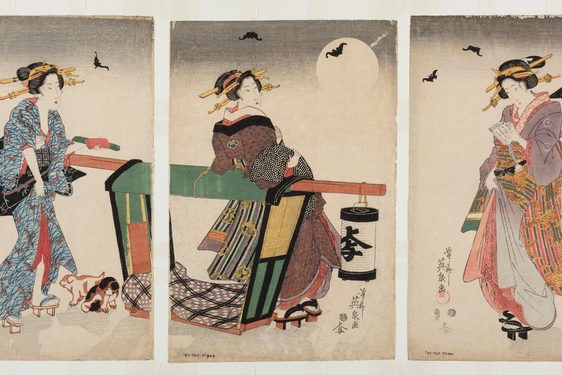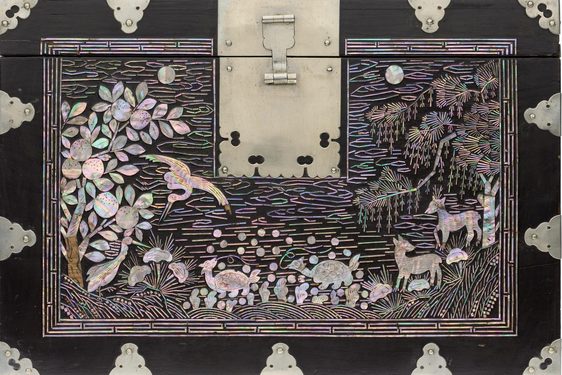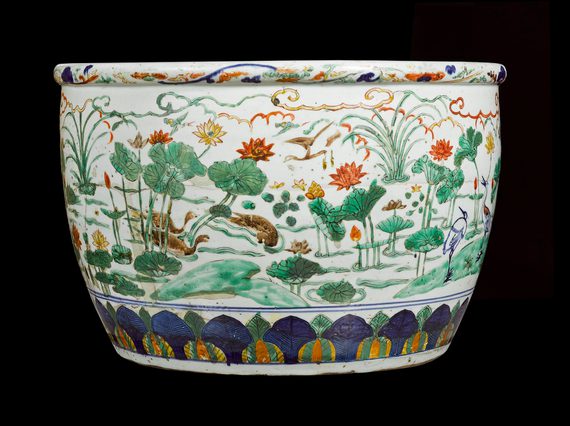
An introduction to our Chinese collection
News Story
From ancient ceramics to imperial jade, oracle bones to contemporary propaganda posters, our Chinese collection spans over four thousand years and includes around 21,000 items.
1. Ceramics
Our ceramic collection includes almost 2,000 items, from all periods and dynasties of Chinese history. This ranges from Late Neolithic cultures such as Yangshao (ca. 5000–3000 BCE), through the Han (206 BCE–220) and Tang (618–907) dynasties. Our collection also spans the Song (960–1279), Yuan (1279–1368), Ming and Qing up until the 20th century, with material from the Cultural Revolution era (1966–1976).
The ceramics in the collection are representative of many different kilns across China. They are of different forms and types, from various periods of production with different glazes, styles, and techniques. The single largest acquisition comprises pieces purchased from Lieutenant-Colonel Kenneth Dingwall (1869–1946) between 1919 and 1925.
There are also many fine examples of export wares intended for the European, and other, markets. These illustrate the skill of Chinese craftsmen in adapting to new markets and tastes. Among the collection are armorial porcelains intended for the European market, including the Scottish and aristocracy.
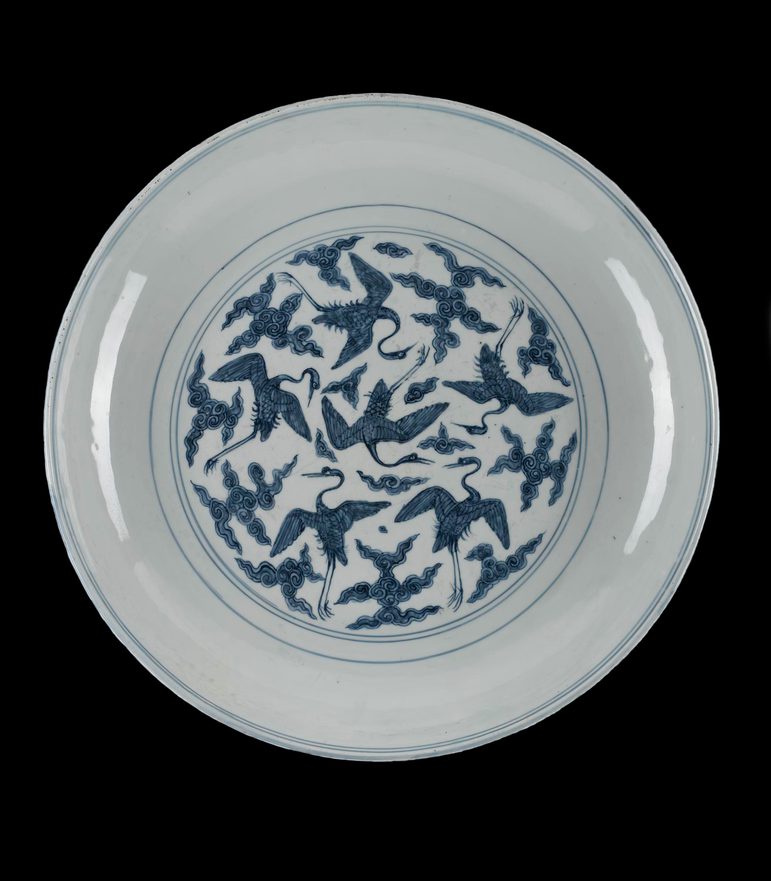
Large porcelain circular dish decorated in underglaze blue with a design of cranes flying among cloud scrolls: China, Ming Dynasty, Jiajing mark and period, 1521 – 1566. Museum reference A.1979.495.
2. Oracle bones
Of great significance is the collection of inscribed oracle bones. Oracle bones are usually made of turtle plastron or oxen scapula. They were used for pyromantic divination by shamans of the late Shang dynasty (c.1600–1046 BCE). The divinatory queries as well as the responses by the spirits were inscribed on the bones in the earliest form of systematic Chinese writing known as oracle bone script.
The Couling-Chalfant oracle bone collection was formed in China between 1903 and 1908 by two missionaries, Samuel Couling (1859–1922) and Frank Chalfant (1862–1914). The collection was assembled only a few years after the oracle bones were recognised for what they are. The 1,500-strong collection was purchased in 1909, making it one of the earliest such collections, and the second largest outside East Asia.
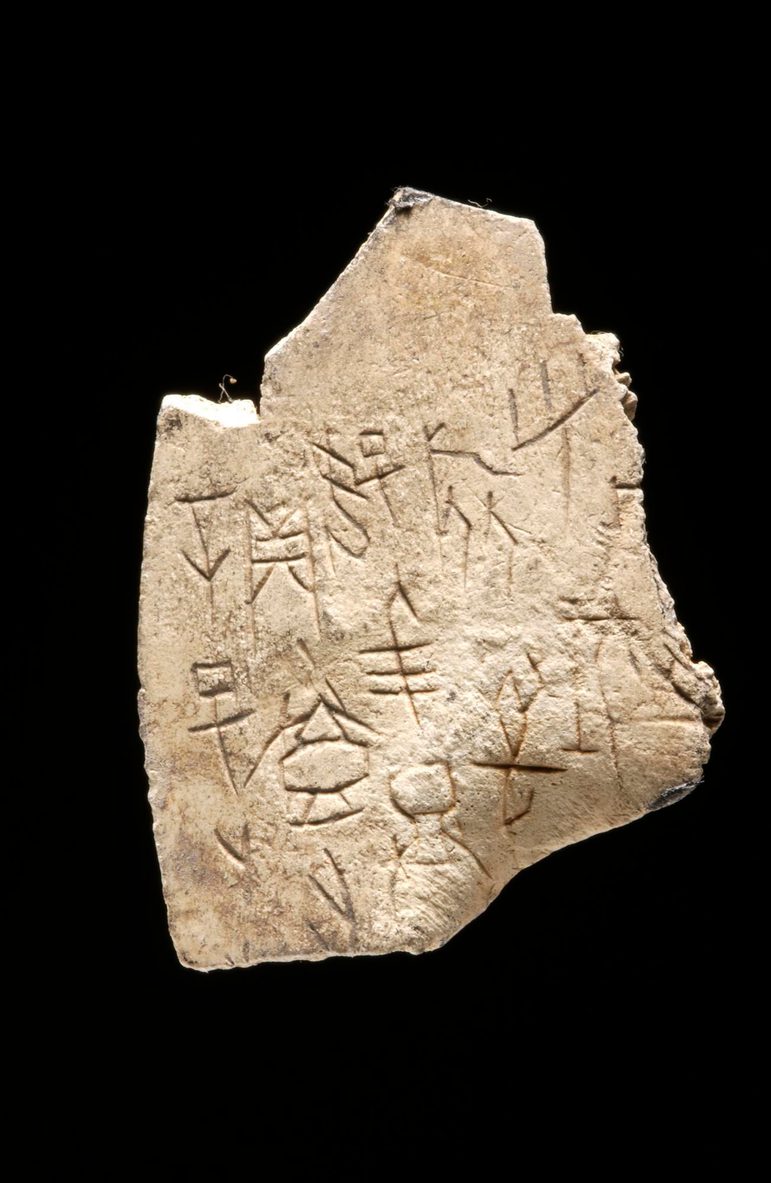
Oracle bone of turtle plastron or ox scapula, with incised script recording divination: China, Henan Province, near Anyang, Yinxu, late Shang dynasty, c. 1250 - 1050 BCE. Museum reference A.1909.384.310.
3. Artefacts with imperial associations
There is an important range of Ming or Qing objects with imperial provenance or association. These are carved jades, ceramics, lacquer, as well as items of dress and accessories worn by civil and military officials featuring the emblems of court rank and status. Among the most notable items in this collection is a group of 65 single pages of finely detailed illustrations painted on silk from the Illustrations of Imperial Ritual Paraphernalia (Huangchao liqi tushi) produced between 1760 and 1766.
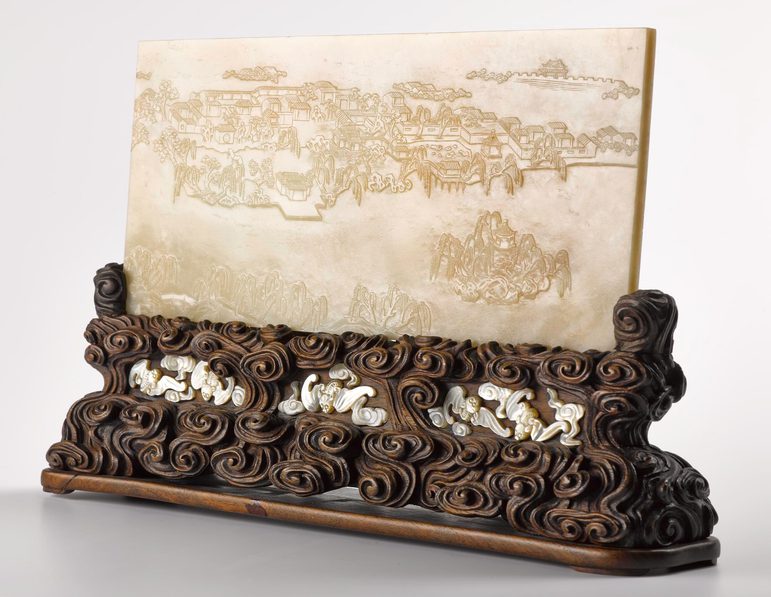
Table screen of pale green jade, engraved on one side with a landscape and on the other with a poem by the Qianlong Emperor, dated 1784, with carved wood stand inlaid with bats in mother-of-pearl: China, Qing Dynasty, Qianlong reign. Museum reference A.1978.590.
4. Paintings, prints and rubbings
Other paintings, prints, and rubbings in the collection include ink rubbings from the Han dynasty Wu Liang Family Shrine and from the Tang Nestorian Stele (781) which documents early Christianity in China.
We have acquired early modern paintings, including work by the monk-painter Xu Gu (1823–1896) and Jiang Jie (fl. 1800–32). Late Qing-period pieces include genre (everyday life subjects) paintings and religious subjects, and anonymous watercolour paintings produced in Guangdong for export to Europe.
In 2013, with the support of the Art Fund, the Museum acquired a large collection of propaganda posters from the 1960s to the 1970s. These illustrate political themes prominent during China's heavily politicised Mao era.
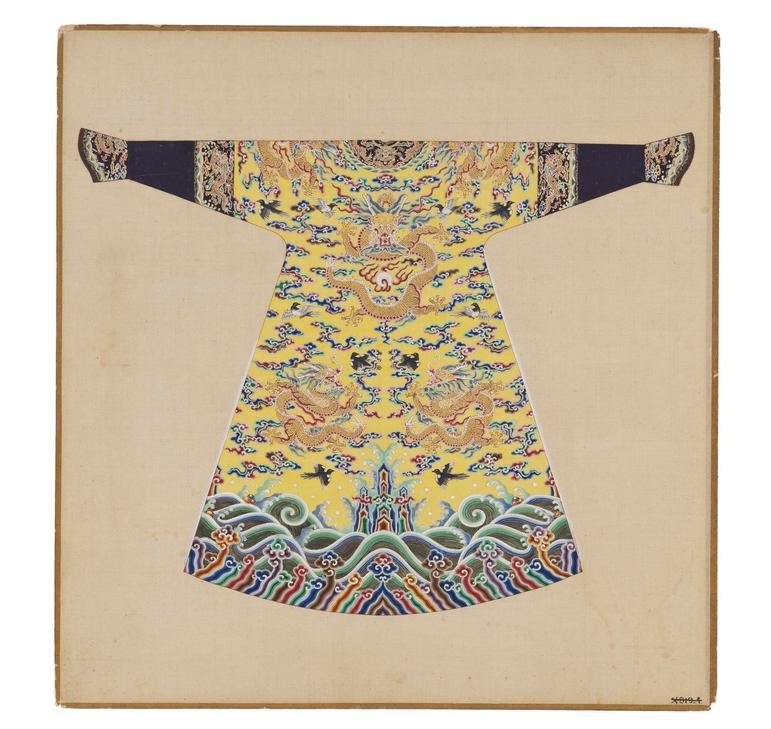
Painting on silk, Illustration of the Imperial Concubine's Semi-formal Dragon Robe, from the "Huangchao liqi tushi" (Illustrations of Imperial Ritual Paraphernalia): China, Qing dynasty, c. 1760 – 1766. Museum reference A.1968.432 S.
5. Textiles and dress
This significant collection dates from the late Qing and the Republican era. Numbering nearly 1,000 items, it features a variety of accessories, headgear and footwear, official and informal dress, seasonal dress and theatrical costumes. This material shows China as an ethnically diverse culture, containing examples of Han dress and those of minorities such as the Manchu and Miao.
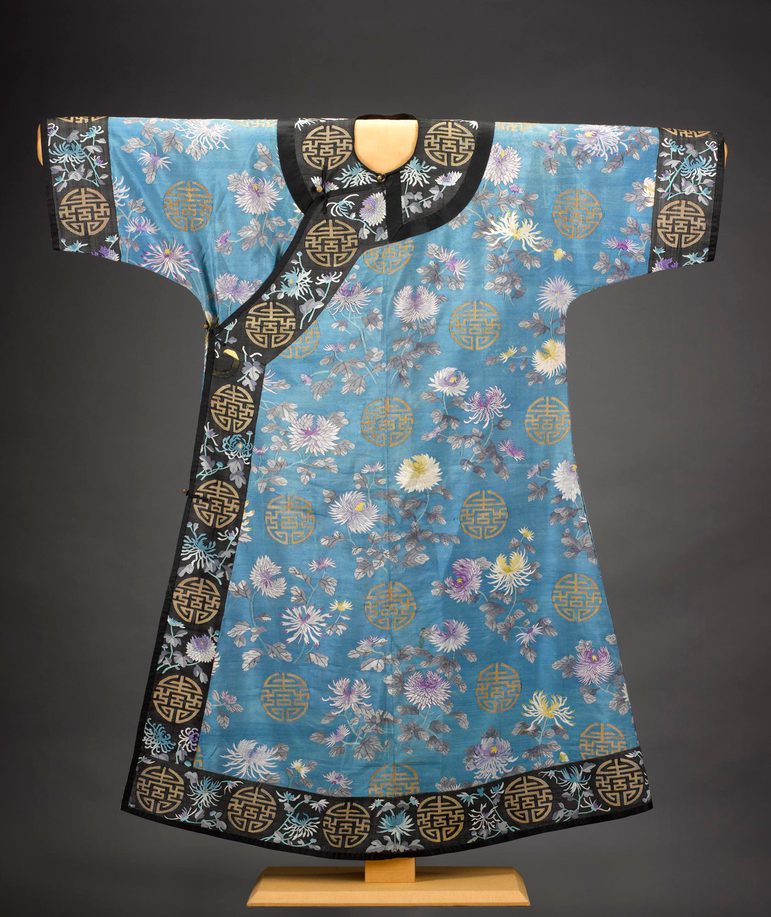
Woman's robe of blue silk in tapestry weave (kesi), with design of chrysanthemums and shou characters, lined with yellow silk, in the style favoured by Empress Dowager Cixi, probably autumnal wear for elder woman: China, Qing Dynasty, late 19th century. Museum reference A.1961.1179.
6. Lacquerware
The lacquer collection is notable and features many fine pieces spanning a number of historical periods. The collection ranges from small lacquer containers and vessels to large pieces of imperial lacquered furniture. Around 20 per cent of the items were part of the collection of the noted scholar of Chinese antiquities Sammy Yukuan Lee (1902–2011).
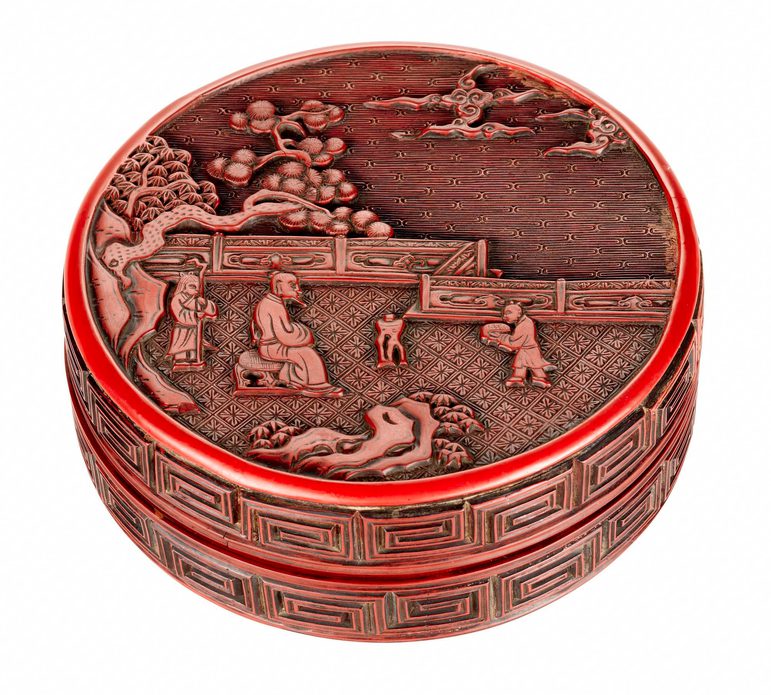
Box of red lacquered wood, small circular, decorated with a sage seated in a garden flanked by two attendants, with thunder pattern on side: China, Yuan dynasty, by Zhang Cheng, 1279 – 1368. Museum reference A.1965.542.
7. Metalwork
The metalwork collection includes a small number of Shang to Han bronze vessels and weapons with some bearing inscriptions. The collection also includes pieces of cloisonné and enamels. Some are of imperial provenance, and some were produced in Guangzhou (formerly Canton) for the export market.
A small number of Buddhist gilt bronzes, of both Chinese and Sino-Tibetan figures of Song to Qing date, exemplify the skill of Chinese craftsmen in producing high quality, large scale gilded bronze figures. China's Buddhist and Daoist traditions are reflected through figurative images in both three and two dimensions of lacquered wood, bamboo, ivory, ceramics, cloisonné, stone, metal, and soapstone.
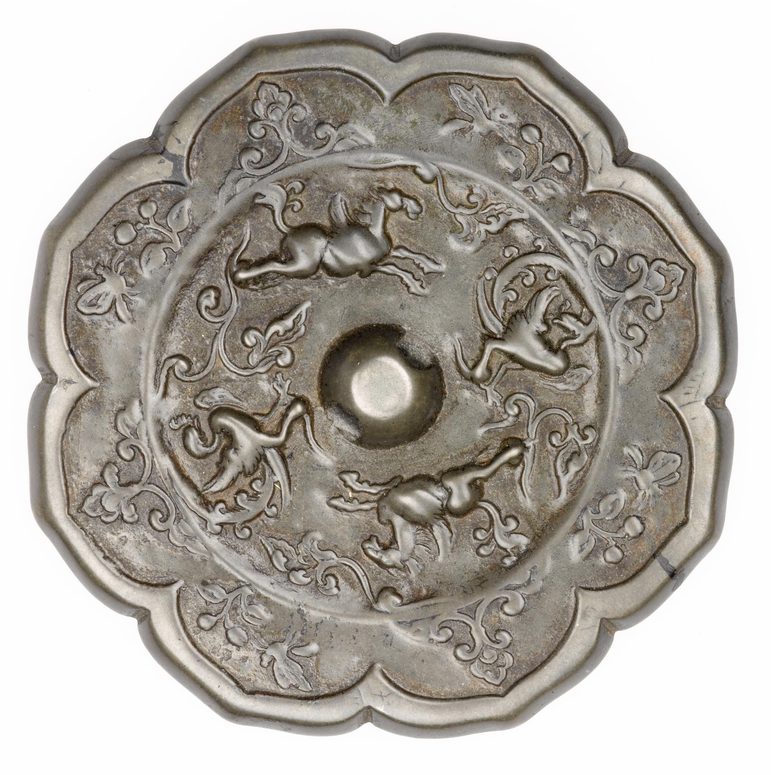
Bronze mirror, ogival with a central boss pierced for a cord, decorated with running winged horses and phoenixes, and a flower and butterfly border: China, Tang dynasty, 618 - 907. Museum reference A.1928.65.
8. Jade, carvings and the scholar's studio
Jade has always been significant in Chinese culture. Later jades and hardstones include some imperially inscribed pieces, as well as figurative carvings, belt plaques, brush pots, table screens, plaques, and vessels.
Carvings in bamboo, wood, ivory and rhinoceros horn are found in the collection, demonstrating the skill of Chinese craftsmen in working across a diverse range of materials. These carvings were produced for and associated with China's literati elites of the Ming and Qing periods. Other arts of the scholar's studio include furniture, brush rests, brushes, table screens, and wrist rests, as well as a wide range of decorative objects that may have been collected, viewed, used, or studied by scholars. There is also a group of carved soapstones mainly for the export market.
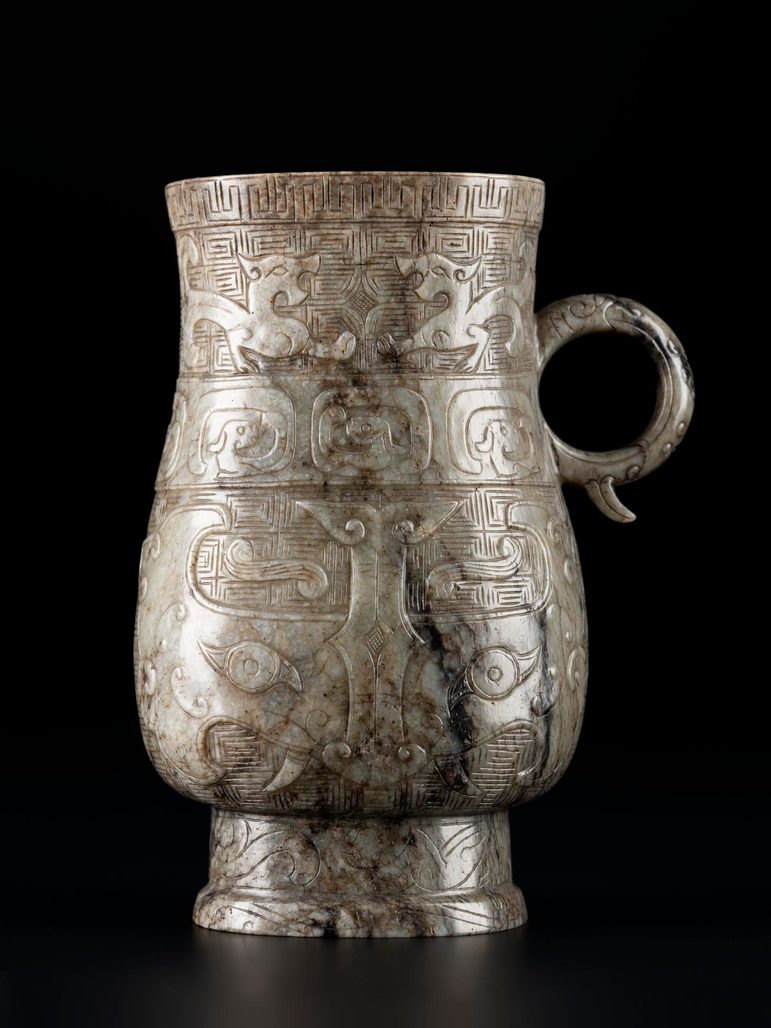
Green jade vase, with a circular handle, carved with symmetrical designs of archaic dragons and ogre masks reserved on a key-fret diaper ground: China, probably Ming dynasty, 1368 - 1644. Museum reference A.1930.224.
9. Important loans
The collection is supported by important loans, most notably from the Royal Collection Trust and George Watson's College. The latter has lent a large group of items relating to Sir James Haldane Stewart Lockhart (1858–1937), who served as a colonial official in Hong Kong. Widely respected, Lockhart rose to the rank of Registrar General and Colonial Secretary of Hong Kong (1895–1902). He then became Commissioner of Weihaiwei (1902–1921) in Shandong province. Lockhart spoke Chinese fluently, and had an affinity with Chinese culture and customs which makes his collection a unique and unparalleled Sino-Scottish collection.
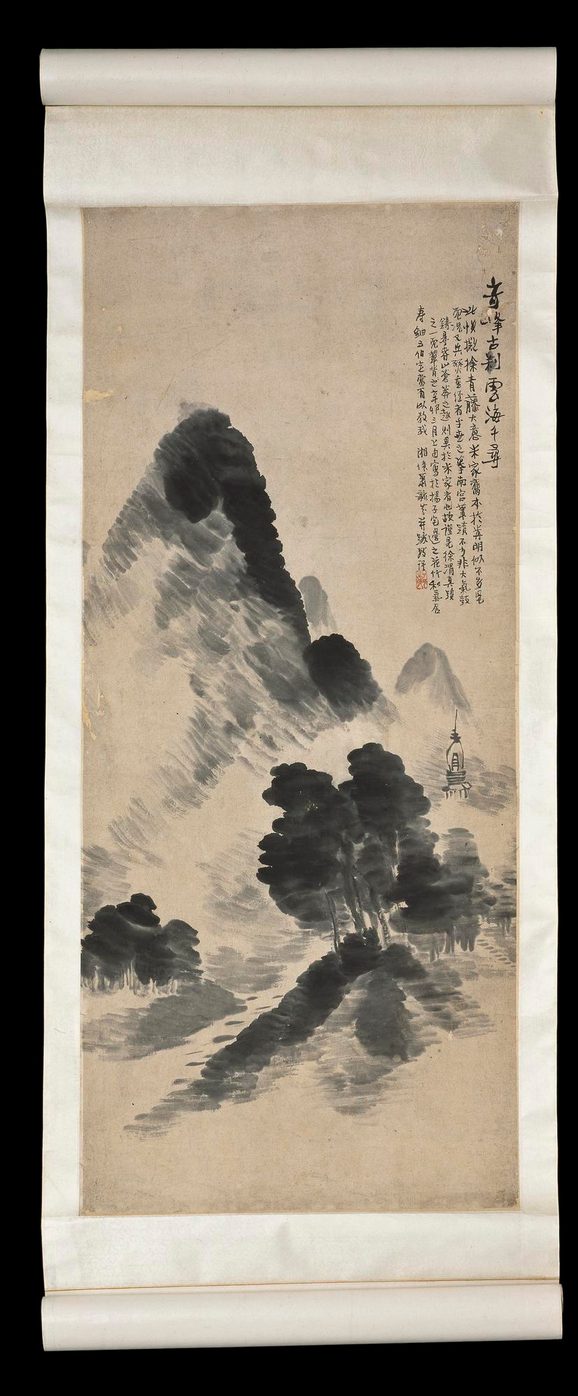
Hanging scroll painting, depicting old temple in the mountains, with inscriptions, signatures and seals, ink on paper, part of a collection of Chinese material collected by Sir James Stewart Lockhart: China, Guangdong province, Zhuhai, by Xiao Yufen, 1891. Courtesy of George Watson's College. Museum reference IL.2003.61.119.
10. Contemporary art
We continue to add to our Chinese collection with acquisitions from contemporary artists across a range of materials. In 2012 a number of ceramics were acquired from the Shanghai design studio Spin Ceramics which showcases 21st-century ceramics in the People's Republic of China. A set of Spin Ceramics flower vases are on display in the Exploring East Asia gallery at the National Museum of Scotland, alongside the glass sculpture pictured above.
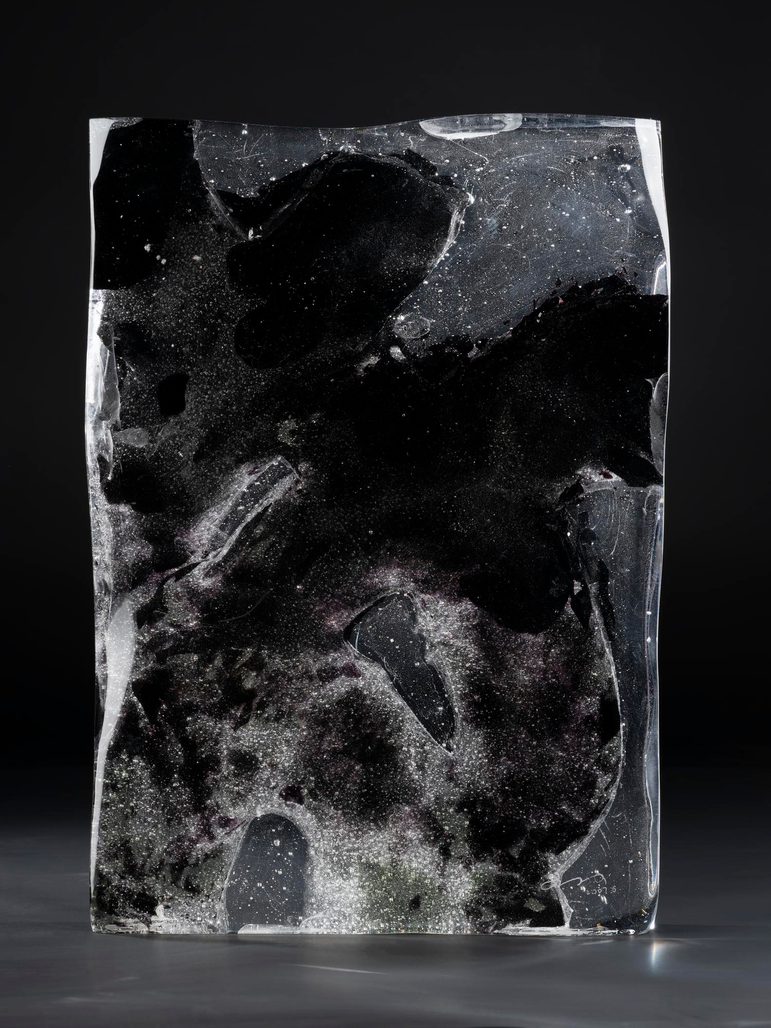
Glass sculpture entitled Calligraphy or Non Calligraphy VIII (Fei shu fei fei shu VIII): China, by Wang Qin, 2007. © Wang Qin; Image © National Museums Scotland. Museum reference V.2008.3.
Header image: Large fish-bowl of coarse porcelain with bluish-white glaze, decorated in overglaze polychrome enamels (wucai) with lotus plants, ducks and herons, and with inscription on the interior rim, used for raising fish and aquatic plants in the imperial palace or gardens: China, Ming Dynasty, Longqing mark and period, 1567 - 1572. Museum reference A.1919.406.
